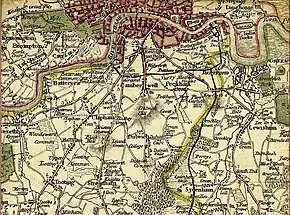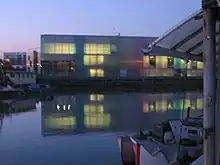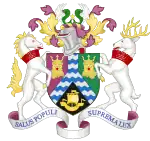Deptford
Deptford is an area on the south bank of the River Thames in southeast London, within the London Borough of Lewisham. It is named after a ford of the River Ravensbourne. From the mid 16th century to the late 19th it was home to Deptford Dockyard, the first of the Royal Dockyards. This was a major shipbuilding dock and attracted Peter the Great to come and study shipbuilding. Deptford and the docks are associated with the knighting of Sir Francis Drake by Queen Elizabeth I aboard the Golden Hind,[1] the legend of Sir Walter Raleigh laying down his cape for Elizabeth,[2] Captain James Cook's third voyage aboard HMS Resolution,[3] and the mysterious apparent murder of Christopher Marlowe in a house along Deptford Strand.[4]
| Deptford | |
|---|---|
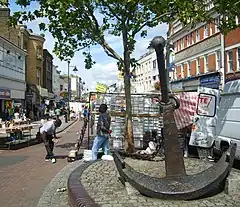 An anchor at the southern end of Deptford High Street links Deptford to its dockyard history | |
 Deptford Location within Greater London | |
| OS grid reference | TQ365775 |
| • Charing Cross | 4.7 mi (7.6 km) WNW |
| London borough | |
| Ceremonial county | Greater London |
| Region | |
| Country | England |
| Sovereign state | United Kingdom |
| Post town | London |
| Postcode district | SE8 |
| Dialling code | 020 |
| Police | Metropolitan |
| Fire | London |
| Ambulance | London |
| UK Parliament | |
| London Assembly | |
Though Deptford began as two small communities, one at the ford, and the other a fishing village on the Thames, Deptford's history and population has been mainly associated with the docks established by Henry VIII. The two communities grew together and flourished during the period when the docks were the main administrative centre of the Royal Navy, and some grand houses like Sayes Court, home to diarist John Evelyn, and Stone House on Lewisham Way, were erected. The area declined as first the Royal Navy moved out, and then the commercial docks themselves declined until the last dock, Convoys Wharf, closed in 2000.
A Metropolitan Borough of Deptford existed from 1900 until 1965, when the area became part of the newly created London Borough of Lewisham.[5]
History
Deptford took its name from a ford across the Ravensbourne (near what is now Deptford Bridge DLR station) along the route of the Celtic trackway which was later paved by the Romans and developed into the medieval Watling Street.[6] The modern name is a corruption of "deep ford".[7]
Deptford was part of the pilgrimage route from London to Canterbury used by the pilgrims in Chaucer's Canterbury Tales, and is mentioned in the prologue to "The Reeve's Tale".[8] The ford developed into first a wooden then a stone bridge, and in 1497 saw the Battle of Deptford Bridge, in which rebels from Cornwall, led by Michael An Gof, marched on London protesting against punitive taxes, but were soundly beaten by the King's forces.[9]
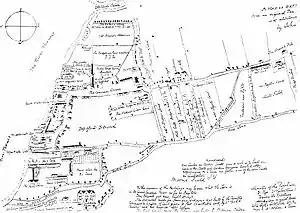
A second settlement, Deptford Strand or Deptford Strond, developed as a modest fishing village on the Thames until Henry VIII used that site for a royal dock repairing, building and supplying ships, after which it grew in size and importance, shipbuilding remaining in operation until March 1869.[10]
Trinity House, the organisation concerned with the safety of navigation around the British Isles, was formed in Deptford in 1514, with its first Master being Thomas Spert, captain of the Mary Rose. It moved to Stepney in 1618. The name "Trinity House" derives from the church of Holy Trinity and St Clement, which adjoined the dockyard.[11]
Originally separated by market gardens and fields, the two areas merged over the years,[12] with the docks becoming an important part of the Elizabethan exploration.[13] Queen Elizabeth I visited the royal dockyard on 4 April 1581 to knight the adventurer Francis Drake.[14] As well as for exploration, Deptford was important for trade – the Honourable East India Company had a yard in Deptford from 1607 until late in the 17th century,[15] later (1825) taken over by the General Steam Navigation Company. It was also connected with the slave trade, John Hawkins using it as a base for his operations,[16] and Olaudah Equiano, the slave who became an important part of the abolition of the slave trade, was sold from one ship's captain to another in Deptford around 1760.[17][18]
Diarist John Evelyn lived in Deptford at Sayes Court, the manor house of Deptford, from 1652 after he had married the daughter of the owner of the house, Sir Richard Browne.[19] After the Restoration, Evelyn obtained a 99-year lease of the house and grounds,[20] and laid out meticulously planned gardens in the French style, of hedges and parterres. In its grounds was a cottage at one time rented by master woodcarver Grinling Gibbons. After Evelyn had moved to Surrey in 1694, Peter the Great, the Russian tsar, studied shipbuilding for three months in 1698 while staying at Sayes Court.[14] Evelyn was angered at the antics of the tsar, who got drunk with his friends who, using a wheelbarrow with Peter in it, rammed their way through a "fine holly hedge". Sayes Court was demolished in 1728-9 and a workhouse built on its site.[20] Part of the estates around Sayes Court were purchased in 1742 for the building of the Navy Victualling Yard, which was renamed the Royal Victoria Victualling Yard in 1858 after a visit by Queen Victoria.[21] This massive facility included warehouses, a bakery, a cattleyard/abattoir and sugar stores, and closed in 1961. All that remains is the name of Sayes Court Park, accessed from Sayes Court Street off Evelyn Street, not far from Deptford High Street. The Pepys Estate, opened on 13 July 1966, is on the former grounds of the Victualling Yard.[22]
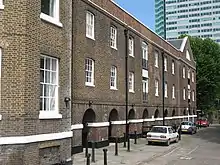
The Docks had been gradually declining from the 18th century; the larger ships being built found the Thames difficult to navigate, and Deptford was under competition from the new docks at Plymouth, Portsmouth and Chatham.[23] When the Napoleonic Wars ended in 1815 the need for a Docks to build and repair warships declined; the Docks shifted from shipbuilding to concentrate on victualling at the Royal Victoria Victualling Yard, and the Royal Dock closed in 1869.[24] From 1871 until 1913 the shipyard site was the City of London Corporation's Foreign Cattle Market, to which live animals were brought by cattle boat from four continents and from whence came about half of London's meat supply.
The yard was taken over by the War Office in 1914,[25][26] and was an Army Supply Reserve Depot in the First and Second World Wars.[27][28] The site lay unused until being purchased by Convoys (newsprint importers) in 1984, and eventually came into the ownership of News International.[29][30] In the mid-1990s, although significant investment was made on the site, it became uneconomic to continue using it as a freight wharf.[31] In 2008 Hutchison Whampoa bought the 16ha site from News International with plans for a £700m 3,500-home development scheme.[32] The Grade II listed Olympia Warehouse will be refurbished as part of the redevelopment of the site.[30]
Deptford experienced economic decline in the 20th century with the closing of the docks, and the damage caused by the bombing during the Blitz in the Second World War – a V-2 rocket destroyed a Woolworths store in New Cross Gate, killing 160 people.[33][34] High unemployment caused some of the population to move away as the riverside industries closed down in the late 1960s and early 1970s.[35] The local council have developed plans with private companies to regenerate the riverside area,[36] and the town centre.[37]
Governance
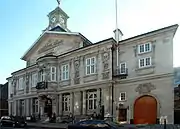
The Manor of Deptford or West Greenwich was bestowed by William the Conqueror upon Gilbert de Magminot or Maminot, bishop of Lisieux,[38] one of the eight barons associated with John de Fiennes for the defence of Dover Castle. Maminot held the head of his barony at Deptford[39][40] and according to John Lyon writing in 1814, he built himself a castle, or castellated mansion at Deptford. The location of the building is not known, but ancient foundations found on the brow of Broomfield, near the Mast Dock and adjacent to Sayes Court may be the remains of the building.[39][40][41]
Deptford was mostly located in the Blackheath Hundred of the county of Kent, with the Hatcham part in the Brixton Hundred of Surrey.[42]
In 1730 was divided into the two parishes of St Nicholas and St Paul.[20] It was also referred to as West Greenwich, with the modern town of Greenwich being referred to as East Greenwich until this use declined in the 19th century.[43] The whole of Deptford came within the Metropolitan Police District in 1830 and was included in the area of responsibility of the Metropolitan Board of Works in 1855.
It was transferred to the County of London in 1889. Originally under the governance of the ancient parishes of St Paul and St Nicholas, in 1900, a Metropolitan Borough of Deptford was formed out of the southern parish of St Paul,[44] with St Nicholas and the area around the Royal Dockyard coming under the governance of the Metropolitan Borough of Greenwich.[5][45]
Under the London Government Act 1963, the Metropolitan Borough of Deptford was absorbed in 1965 into the newly created London Borough of Lewisham,[46] with the Deptford St Nicholas area becoming part of the Royal Borough of Greenwich, with both these new boroughs now forming part of the new Greater London body. In 1994 the bulk of the northern part, including the former Royal Dockyard area, was transferred to Lewisham, an adjustment of about 40 hectares (99 acres),[47] leaving only the north eastern area, around St Nicholas's church, in Greenwich.
Deptford is split between two electoral wards - Evelyn in the north and part of New Cross to the south.[48] Following public consultation, the Local Government Boundary Commission for England recommended in June 2020 that the Deptford wards (Evelyn and New Cross) should be unified and renamed Deptford.[49]
Geography
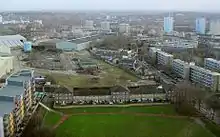
Deptford borders the areas of Brockley and Lewisham to the south, New Cross to the west and Rotherhithe to the north west; the Ravensbourne river divides it from Greenwich to the east, and the Thames separates the area from the Isle of Dogs to the north east; it is contained within the London SE8 post code area.[50] The area referred to as North Deptford is the only part of the London Borough of Lewisham to front the Thames and is sandwiched between Rotherhithe and Greenwich. Much of this riverside estate is populated by the former Naval Dockyards, now known as Convoys Wharf, the Pepys Estate and some southern fringes of the old Surrey Commercial Docks.
The name Deptford – anciently written Depeford meaning "deep ford"[20] — is derived from the place where the road from London to Dover, the ancient Watling Street (now the A2), crosses the River Ravensbourne at the site of what became Deptford Bridge at Deptford Broadway. The Ravensbourne crosses under the A2 at roughly the same spot as the Docklands Light Railway (DLR) crosses over; and at the point where it becomes tidal, just after Lewisham College, it is known as Deptford Creek, and flows into the River Thames at Greenwich Reach.[51]
Demography
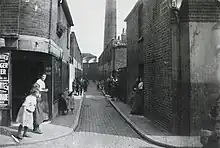
Deptford's population has been mainly associated with the docks since the establishment of the Royal Docks by Henry VIII, though there has also been some market gardening and potteries.[52] When the docks were thriving as the main administrative centre of the British Navy, so the area prospered, and fine houses were built for the administrative staff and the skilled shipbuilders, and a few grand houses like Sayes Court and Stone House on Lewisham Way were erected.[53]
There was a start of a demographic shift downwards when the Royal Navy pulled out of Deptford, and the docks moved into storage and freight.[54] The downward shift continued into the 20th century as the local population's dependency on the docks continued: as the docks themselves declined, so did the economic fortune of the inhabitants until the last dock, Convoys Wharf, closed in 2000.[55]
In common with neighbouring areas of South East London, immigrants from the Caribbean settled in Deptford in the 1950s and 1960s.[56]
Deptford's northern section nearest the old docks contains areas of council housing, with some concentrations of people experiencing the forms of deprivation typically associated with the poverty of Inner London. Northern Deptford near the Thames, along with neighbouring New Cross, has been touted as "the new Shoreditch" by some journalists and estate agents paying attention to a trendy arts and music scene that is popular with students and artists.[57] To the south where Deptford rolls into the suburban spread of Brockley, the previously multi-occupancy Victorian houses are being gentrified by young city workers and urban professionals.[58] Deptford has a growing Vietnamese community reflected in the number of restaurants in the area.
Deptford contains a number of student populations, including those of Goldsmiths College, the University of Greenwich, Bellerbys College and Laban Dance Centre. Goldsmiths College's hall of residence, Rachel McMillan, in Creek Road was sold in 2001 for £79 million,[59] and was subsequently demolished and replaced with the McMillan Student Village which opened in 2003 and provides accommodation for approximately 970 students of the University of Greenwich, Trinity Laban and Bellerbys colleges.[60]
Economy
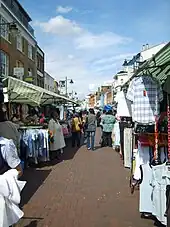
Deptford's economic history has been strongly connected to the Dockyard - when the Dockyard was thriving, so Deptford thrived; with the docks now all closed, Deptford has declined economically.[24][35] However, areas of Deptford are being gradually re-developed and gentrified - and the local council has plans to regenerate the riverside and the town centre.[37] A large former industrial site by the Thames called Convoys Wharf is scheduled for redeveloping into mixed use buildings. This will involve the construction of around 3,500 new homes and an extension of the town centre northwards towards the river.[36]
The site of a former foundry (established in 1881 by J. Stone & Co in Arklow Road) which closed in 1969 is being redeveloped for commercial and residential use.[61]
Much of the area along Creek Road, close to Greenwich, has also been redeveloped, with the demolition of the old Deptford Power Station and Rose Bruford College buildings. Aragon Tower on the Pepys Estate was sold by Lewisham Borough to fund regeneration plans for the estate; the award-winning refurbishment into privately owned accommodation was featured in the BBC One documentary, "The Tower".[62][63]
Deptford Market, a street market in Deptford High Street sells a range of goods, and is considered one of London's liveliest street markets.[64] In February 2005, the High Street was described as "the capital's most diverse and vibrant high street" by Yellow Pages business directory, using a unique mathematical formula.[65]
Culture
The Albany Theatre, a community arts centre with a tradition of "radical community arts and music" including holding 15 "Rock Against Racism" concerts,[66] has its roots in a charity established in 1894 to improve the social life of Deptford's deprived community.[67] The original building, the Albany Institute, was opened in 1899 on Creek Road, changing its name in the 1960s to the Albany Empire. It was burnt down in 1978, but rebuilt on Douglas Way, with Prince Charles laying the foundation stone, and Diana, Princess of Wales opening it in 1982.[67]
Deptford Cinema is a volunteer run, not-for-profit, community cinema, art gallery, and occasional music venue, open since late 2014 and located at 39 Deptford Broadway. At the time of opening it was the borough of Lewisham's only functioning cinema.[68]
Creekside, a regeneration area beside Deptford Creek,[69] is used for educational and artistic purposes,[70][71] such as the Laban Dance Centre, which was designed by Swiss architects Jacques Herzog and Pierre de Meuron, and opened in February 2003; and the Art in Perpetuity Trust (APT) gallery and studio space.[72] A record label, Deptford Fun City Records was set up by Miles Copeland III, brother of Stewart Copeland, in the late 1970s as an outlet for Deptford bands such as Alternative TV[73] and Squeeze.[74][75]
The area has several pubs, including the Dog & Bell which has a reputation for serving a range of cask ales;[76][77] and The Bird's Nest which has live music, film and art performances from local bands and artists.[78][79] The town hall of the former Metropolitan Borough of Deptford, built in 1905 with decorative sculpture by Henry Poole,[80] lies just outside Deptford, on the New Cross Road in New Cross. It was purchased by Goldsmiths College in 2000.[81]
There are several green spaces in the area, the largest being Brookmill Park, Deptford Park, Ferranti Park, Pepys Park and Sayes Court Park.[82] In 1884 William John Evelyn, a descendant of John Evelyn, sold ground then being used as market gardens in Deptford, to the London County Council for less than its market value, as well as paying toward the cost of its purchase. It was officially opened to the public as Deptford Park on 7 June 1897.[83][84] In 1886, he dedicated an acre and a half of the Sayes Court recreation ground in perpetuity to the public and a permanent provision was made for the Evelyn estate to cover the expense of maintenance and caretaking, this was opened on 20 July 1886.[85][86]
Transport
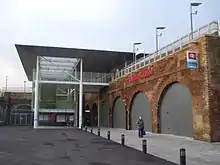
Deptford is served by National Rail and Docklands Light Railway services. The National Rail service is operated by Southeastern and Thameslink on the suburban Greenwich Line at Deptford railway station,[87] the oldest passenger only railway station in London.[88][89] Deptford station was redeveloped during 2011 and 2012. The works included the demolition of the original 1836 station building and its replacement by a new station to the west in the former station yard.[90][91] Deptford's DLR station is at Deptford Bridge on the DLR's Lewisham branch.[92][93]
There are two main road routes through Deptford: the A200 which runs along Evelyn Street and Creek Road,[94] and the A2 which runs along New Cross Road, and is the modern version of the Celtic trackway which was later paved by the Romans and developed into the medieval Watling Street.[6][95] The A20 marks the southern boundary of the area, along Lewisham Way and Loampit Vale.[96]
Since June 2016, Deptford has been on the cycling route of the London Quietway route Q1 that starts in Greenwich and ends near Waterloo Bridge in central London.[97] A second Quietway route, Q14, between Waterloo and Thamesmead, passes through Deptford's riverfront.[98]
Education
There are five primary schools in the area.[99] There are no local secondary schools directly in Deptford, however there are two secondary schools near the border between New Cross and Deptford: Deptford Green, regarded by Ofsted as "needing improvement",[100] and Addey and Stanhope, regarded by Ofsted as "good".[101] A branch of the further education college, Lewisham College incorporating Southwark College (known as LeSoCo), is located on Deptford Church Street; the college was regarded as "inadequate" in the 2014 Ofsted inspection.[102]
Landmarks

Deptford railway station is one of the oldest suburban stations in the world,[103] being built (c.1836-38) as part of the first suburban service (the London and Greenwich Railway), between London Bridge and Greenwich. Close to Deptford Creek is a Deptford pumping station, a Victorian pumping station built in 1864, part of the massive London sewerage system designed by civil engineer Sir Joseph Bazalgette.[104]
The former Deptford Power Station, in use from 1891 to 1983, originated as a pioneering plant designed by Sebastian de Ferranti, which when built was the largest station in the world.[105]
In 2008, Lewisham Council granted permission for the last remnants of the Deptford Ragged School known as The Princess Louise Institute to be demolished and replaced by flats.[106]
Albury Street (previously Union Street) contains a fine row of early urban houses largely dating from 1705 to 1717 which were once popular with naval captains and shipwrights.[107]
Tanners Hill in the St John's or New Deptford area to the south of New Cross Road,[108] is part of an Area of Archaeological Priority due to the longevity of settlement and early industry,[109] and contains a set of commercial buildings from numbers 21 to 31 which are survivors from a row of 31 which were built in the 1750s on the site of cottages dating from the 17th century.[110]
These timber-frame buildings have a Grade II listing from English Heritage[111] and are home to established businesses such as bicycle maker Witcomb Cycles.[112] Of Deptford's two important houses, Sayes Court no longer exists, but the Stone House in St Johns, built around 1772 by the architect George Gibson the Younger, and described by Pevsner as "the one individual house of interest in this area", still stands by Lewisham Way.[113]
Deptford's Albany Theatre has a history stretching back over 100 years and is a prominent feature of the South-East London arts scene.
Churches
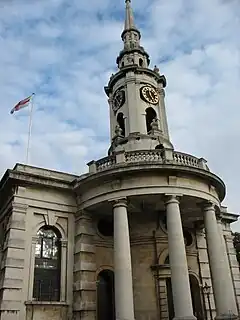
St Nicholas's Church, the original parish church, dates back to the 14th century but the current building is 17th century. The entrance to the churchyard features a set of skull-and-bones on top of the posts. A plaque on the north wall commemorates playwright Christopher Marlowe, who was stabbed to death by Ingram Frizer in a nearby house, and buried in an unmarked grave in the churchyard on 1 June 1593. Frizer was pardoned for the killing on the grounds that he acted in self-defence.[114][115]
There is also St. Luke's, another historic circular church, dating from 1870. It is the daughter church of the parish of St Nicholas'.
In the 18th century St. Paul's, Deptford (1712–1730) was built,[116] acclaimed by the Royal Commission on the Historical Monuments of England as one of the finest Baroque churches in the country.[117] John Betjeman is attributed as referring to the church as "a pearl at the heart of Deptford".[118] It was designed by the architect Thomas Archer, who was a pupil of Sir Christopher Wren, as part of the Commission for Building Fifty New Churches with the intention of instilling pride in Britain, and encouraging people to stay in London rather than emigrate to the New World.[119]
Adjacent to the church yard is Albury Street, which contains some fine 18th-century houses which were popular with sea captains and shipbuilders.[120]
Deptford Dockyard

Deptford Dockyard was established in 1513 by Henry VIII as the first Royal Dockyard, building vessels for the Royal Navy,[121] and was at one time known as the King's Yard.[122] It was shut down from 1830 to 1844 before being closed as a dockyard in 1869,[123] and is currently known as Convoys Wharf. From 1871 until the First World War it was the City of London Corporation's Foreign Cattle Market. In 1912, The Times reported that over 4 million head of live cattle, and sheep, had been landed.
From 1932 until 2008 the site was owned by News International, which used it to import newsprint and other paper products from Finland until early 2000. It is now owned by Hutchison Whampoa Limited and is subject to a planning application to convert it into residential units,[124] though it has safeguarded wharf status.[125]
Other notable shipyards in Deptford were Charles Lungley's Dockyard and the General Steam Navigation Company's yards at Deptford Green and Dudman's Dock, also sometimes referred to as Deadmans Dock at Deptford Wharf.
Murder of Christopher Marlowe
.jpg.webp)
The Elizabethan playwright Christopher Marlowe was killed during an alleged drunken brawl in Eleanor Bull's house in Deptford Strand in May 1593. Various versions of Marlowe's death were current at the time. Francis Meres says Marlowe was "stabbed to death by a bawdy serving-man, a rival of his in his lewd love" as punishment for his "epicurism and atheism".[126] In 1917, in the Dictionary of National Biography, Sir Sidney Lee wrote that Marlowe was killed in a drunken fight. Some modern theories posit that he was assassinated.[127] It is commonly assumed that the fight took place in a Deptford tavern.[128]
The scholar Leslie Hotson discovered in 1925 the coroner's report on Marlowe's death in the Public Record Office which gave fuller details.[129] Marlowe had spent all day in a house owned by the widow Eleanor Bull, along with three men, Ingram Frizer, Nicholas Skeres and Robert Poley.[130] Witnesses testified that Frizer and Marlowe had earlier argued over the bill, exchanging "divers malicious words." Later, while Frizer was sitting at a table between the other two and Marlowe was lying behind him on a couch, Marlowe snatched Frizer's dagger and began attacking him. In the ensuing struggle, according to the coroner's report, Marlowe was accidentally stabbed above the right eye, killing him instantly.[129] The jury concluded that Frizer acted in self-defence, and within a month he was pardoned. Marlowe was buried in an unmarked grave in the churchyard of St Nicholas, Deptford, on 1 June 1593.[131]
Notable people
Among people associated with Deptford are Christopher Marlowe, who was stabbed to death at Deptford Strand;[132] diarist John Evelyn (1620–1706), who lived at Sayes Court,[133] and had Peter the Great (1672–1725) as a guest for about three months in 1698;[134] Sir Francis Drake, who was knighted by Queen Elizabeth I aboard the Golden Hind in Deptford Docks;[135] and Emperor Norton (Joshua Abraham Norton), the San Francisco eccentric and self-proclaimed "Emperor of the United States", who was born in Deptford in 1818.[136]
Other people who have lived in Deptford range from the first governor of the East India Company and ambassador to the court of Russia, Thomas Smythe, whose magnificent house was destroyed by fire in 1618;[20] to early members of the Chartist movement, John Gast[137] and George Julian Harney;[138] and the Cleveleys, John Cleveley the Elder and his sons John and Robert, a family of marine artists who also worked as tradesmen in the Dockyard.[139] Another artist born in Deptford is Henry Courtney Selous,[140] who is known for The Opening of The Great Exhibition, painted in 1851.[141]
Members of rock groups Squeeze and Dire Straits lived on the Crossfield Estate in Deptford in the late 1970s,[142][143] along with Mark Perry, founder of the punk fanzine Sniffin Glue and punk rock band Alternative TV.[144] The DJ and music journalist Danny Baker lived near the Crossfield Estate, where he was born and brought up.[145]
Children's author Robin Jarvis wrote two trilogies of books: The Deptford Mice (and a couple of spin off books called The Deptford Mouselets series) and The Deptford Histories, set in and around Deptford and featuring many of its landmarks.[146][147]
References
- Sir Francis Drake: The Queen's Pirate, pp 218-19, H Kelsey, Yale University Press (1 September 2000), ISBN 0-300-08463-3
- Sir Walter Ralegh and the Quest for El Dorado, pages 83 & 176, Marc Aronson, Clarion Books (17 April 2000), ISBN 0-395-84827-X
- Captain James Cook, pp 273-294, Richard Hough, W.W. Norton (17 August 1996), ISBN 0-393-31519-3
- Greenwich 2000 (5 January 2010). "Greenwich England: Deptford". Wwp.greenwich2000.com. Archived from the original on 19 February 2014. Retrieved 5 July 2010.
- Archived 8 June 2011 at the Wayback Machine Lewisham Borough Historical resource
- "Roman and Saxon Roads and Transport". Dartford archive. Kent County Council – via Dartford Grammar School.
- Patrick Hanks; Flavia Hodges; Mills, A. D.; Room, Adrian (2002). The Oxford Names Companion. Oxford: The University Press. p. 1003. ISBN 978-0-19860561-4.
- Geoffrey Chaucer. "The Reeve's Prologue". Harvard University. line 3906. Archived from the original on 20 June 2019. Retrieved 20 June 2019.
- Daniel Lysons; Samuel Lysons (1811). The Environs of London: pt. 2. p. 468.
- Deptford, Old and New London: Volume 6 (1878), pp. 143–64. accessed: 19 September 2009
- Geoffrey Moorhouse (2005). Great Harry's Navy. London: Weidenfeld & Nicolson. pp. 169, 170. ISBN 978-0-297-64544-3.
- "Deptford". Ideal homes. Archived from the original on 1 June 2008. Retrieved 17 August 2008.
- "The Tudor and Stuart port". About maritime London. Port Cities. Archived from the original on 22 December 2008. Retrieved 9 January 2010.
- Greenwich 2000 - Deptford Strand Archived 11 July 2011 at the Wayback Machine
- "The East India Company's Yard at Deptford". Port cities. Archived from the original on 9 June 2011. Retrieved 5 July 2010.
- "Slavetrade in the caribbean, from the beginning till abolishment". Paradise inn Carriacou. Archived from the original on 12 April 2010. Retrieved 9 January 2010.
- "Olaudah Equiano, UK". It's Caribbean. Archived from the original on 13 October 2008. Retrieved 9 January 2010.
- The Interesting Narrative of the Life of Olaudah Equiano Or Gustavus Vassa, The African, Written By Himself, Volume 1, Olaudah Equiano, Kessinger Publishing, 2004, ISBN 1419167499
- Douglas D. C. Chambers, 'Evelyn, John (1620–1706)', Oxford Dictionary of National Biography, Oxford University Press, September 2004; online edn, January 2008, accessed 13 January 2008.
- Daniel Lysons (1796). Deptford, St Nicholas, The Environs of London: volume 4: Counties of Herts, Essex & Kent. pp. 359–85.
{{cite book}}:|work=ignored (help) - "Deptford & Millwall - add info". London-footprints.co.uk. Archived from the original on 20 August 2009. Retrieved 5 July 2010.
- "Pepys Estate Tenants Action Group". Archived from the original on 26 June 2009. Retrieved 11 June 2010.
- "Deptford and Woolwich: London's Royal Dockyards - London's docks and shipping - Port Cities". portcities.org.uk. Archived from the original on 10 January 2010. Retrieved 14 January 2010.
- "Deptford and Woolwich: London's Royal Dockyards - London's docks and shipping - Port Cities". portcities.org.uk. Archived from the original on 31 December 2009. Retrieved 14 January 2010.
- Sale of Deptford Market. Government to Pay £387,000. The Times, 13 March 1926, p.12, col F
- Future of Deptford Market. War Office decision to buy. The Times, 6 February 1924, p12, col B
- Greenwich Industrial History Proposal to list the remains of the Royal Dockyard at Deptford 6 January 2010
- PRO Archived 5 January 2010 at the Wayback Machine Works 43/614-6
- london-footprints.co.uk Archived 20 July 2008 at the Wayback Machine Deptford Dockyard
- Convoys Wharf London Archived 3 October 2009 at the Wayback Machine, Richard Rogers Partnership, 2002
- Safeguarded Wharves on the River Thames - London Plan Implementation Report Archived 4 June 2011 at the Wayback Machine, Mayor of London, January 2005, pp 60-63
- "Mothballed £700m Deptford housing scheme on track". Building. 6 November 2009. Retrieved 5 July 2010.
- Steve Crawshaw (2004). Easier Fatherland: Germany and the Twenty-First Century. A&C Black. p. 170. ISBN 978-0-8264-6320-3.
- "Flying Bombs & Rockets". Archived from the original on 14 December 2012. Retrieved 15 January 2010.
- "About". Deptford Town Centre. Towntalk. Archived from the original on 1 January 2013. Retrieved 14 January 2010.
- "Concept". richardrogers.co.uk. Archived from the original on 3 October 2009. Retrieved 19 December 2009.
- "Proposals for the regeneration of Deptford town centre". Lewisham Council. Archived from the original on 8 June 2011. Retrieved 14 January 2010.
- A History of Deptford Dews, N, (London, 1884)
- Lyon, John (1814). The history of the town and port of Dover and of Dover castle by John Lyon, published 1814, p. 139. Retrieved 5 July 2010.
- Dedication to the Public of Deptford Park by Dr W.J. Collins, 1897
- Ireland, William Henry (1830). England's topographer, or A new and complete history of the county of Kent by William Henry Ireland, 1830, page 731. Retrieved 5 July 2010.
- 'Parishes: Hatcham (Parish of Deptford St Paul)', A History of the County of Surrey: Volume 4 (1912) pp. 42-44. accessed: 19 September 2009
- "The History and Topographical Survey of the County of Kent: Volume 1 (1797), pp. 340-71". British-history.ac.uk. 22 June 2003. Retrieved 5 July 2010.
- Great Britain Historical GIS / University of Portsmouth, Deptford MB (historic map). Retrieved {{{accessdate}}}. "Deptford MetB through time | Administrative history of Local Government District: Hierarchies, boundaries". Archived from the original on 12 April 2012. Retrieved 4 August 2008.
{{cite web}}: CS1 maint: bot: original URL status unknown (link) - Great Britain Historical GIS / University of Portsmouth, Deptford St Nicholas (historic map). Retrieved {{{accessdate}}}. "Deptford St Nicholas CP/AP through time | Administrative history of Parish-level Unit: Hierarchies, boundaries". Archived from the original on 12 April 2012. Retrieved 4 August 2008.
{{cite web}}: CS1 maint: bot: original URL status unknown (link) - Museum of London
- OPSI - Greenwich and Lewisham (London Borough Boundaries) Order 1993
- "About the Area". neighbourhood.statistics.gov.uk. Archived from the original on 4 June 2011. Retrieved 29 December 2009.
- "New electoral arrangements for Lewisham Council Final Recommendations" (PDF). Local Government Boundary Commission for England. June 2020. pp. 10–11. Archived (PDF) from the original on 4 March 2021.
- "Location of Deptford telephone exchange". streetmap.co.uk. Archived from the original on 23 October 2012. Retrieved 29 December 2009.
- "Deptford Creek - About maritime London - Port Cities". portcities.org.uk. Archived from the original on 3 March 2009. Retrieved 19 December 2009.
- Demographic, social and economic indices for wards in Greater London, Eric J. Thompson, Greater London Council (1972), ASIN B0006D80AS
- "St John's, Deptford New Town Case Study". ideal-homes.org.uk. Archived from the original on 10 April 2008. Retrieved 17 August 2008.
- Demographic review of Greater London 1983, Greater London Council (1983), ISBN 0-7168-1348-3
- INFORMATION SHEET Deptford and the dockyards Archived 10 July 2011 at the Wayback Machine The Emancipation of the Dispossessed
- UCL Case Study - Deptford https://www.ucl.ac.uk/urbanbuzz/downloads/projects_09/Deptford_Case_Study.pdf
- "PrimeLocation.co.uk". PrimeLocation.co.uk. Retrieved 5 July 2010. Shoreditch is a former working class area of East London that has a number of contemporary art galleries and is home to a number of creative and media companies
- "Lewisham Deptford". ukpollingreport.co.uk. Retrieved 5 July 2010.
- Rachel McMillan, Greenwich, Opal savills.com
- "McMillan Student Village". Accommodation - University of Greenwich. gre.ac.uk. Archived from the original on 22 August 2009. Retrieved 29 December 2009.
- "Deptford Foundry, Arklow Road". Turley. Archived from the original on 3 April 2018. Retrieved 3 April 2018.
- "Television: Kathryn Flett on Paris". The Guardian. London. 1 July 2007. Retrieved 19 December 2009.
- "2006 - Berkeley Homes". berkeleyhomes.co.uk. Retrieved 19 December 2009.
- "London's Best Markets - Time Out London". timeout.com. Archived from the original on 15 September 2008. Retrieved 16 August 2008.
- Yell Group, Deptford is Top of the Shops - New study reveals London's hidden gems in the High Street Hit Parade, 23 February 2005.
- Gilchrist, Ruth; Jeffs, Tony (March 2001). Settlements, social change and ... - Google Books. Jessica Kingsley Publishers. ISBN 978-1-85302-764-2.
- "The Albany – Get Involved: Albany History". thealbany.org.uk. Archived from the original on 28 November 2009. Retrieved 19 December 2009.
- Emily Hennings (17 February 2018). "5 independent cinemas in SE London perfect for a date or great night out". News Shopper. London: Newsquest. Retrieved 11 April 2018.
- Hough, Michael (15 June 2004). Cities and natural process: a basis ... - Google Books. Psychology Press. ISBN 978-0-415-29854-4.
- "Creekside - About Creekside". creeksidecentre.org.uk. Archived from the original on 28 March 2010. Retrieved 29 December 2009.
- "Creekside Artists". Deptford, South East London, UK: creeksideartists.co.uk. Retrieved 29 December 2009.
- "APT - Art in Perpetuity Trust". aptstudios.org. Archived from the original on 18 July 2009. Retrieved 29 December 2009.
- Sabin, Roger (1999). Punk rock: so what?: the cultural ... - Internet Archive. Routledge. p. 65. ISBN 978-0-415-17029-1. Retrieved 8 January 2010.
Deptford Fun City Records.
- Paul Marko Borthwick, Stuart; Moy, Ron (2004). Popular music genres: an introduction - Google Books. ISBN 978-0-7486-1745-6.
- The Roxy London Wc2: A Punk History. The Roxy Club London:Punk. 15 October 2007. ISBN 978-0-9556583-0-3. Retrieved 8 January 2010.
- "Dog & Bell - Deptford - Review - Time Out London". timeout.com. Archived from the original on 3 October 2009. Retrieved 11 January 2010.
- "Dog and Bell, Deptford, London pub guide". fancyapint?. Archived from the original on 27 May 2010. Retrieved 11 January 2010.
- "The Bird's Nest, Deptford, London pub guide". fancyapint?. Archived from the original on 20 February 2010. Retrieved 11 January 2010.
- "DEPTFORD ARMS - Open Mic & Open To Art". Artrocker. Archived from the original on 3 June 2011. Retrieved 11 January 2010.
- Raymond McKenzie (1 December 2001). Public sculpture of Glasgow. Liverpool University Press. ISBN 978-0-85323-937-6. Retrieved 29 December 2009.
- "Deptford Town Hall, New Cross Road, New Cross, c. 1910". ideal-homes.org.uk. Archived from the original on 19 August 2008. Retrieved 29 December 2009.
- "London-Footprints' Green Deptford Walk". London-footprints.co.uk. 16 June 1944. Archived from the original on 23 September 2009. Retrieved 5 July 2010.
- Lewisham.gov.uk's description of Deptford Park Archived 12 February 2010 at the Wayback Machine
- Dedication to the public of Deptford Park Archived 8 June 2011 at the Wayback Machine by William Job Collins, 7 June 1897, London County Council.
- Sayes Court, Deptford, The Times, 20 July 1886, p. 5, col F
- Public Recreation Grounds, The Times, 21 July 1886, p. 9, col F
- "National Rail Enquiries - Station Facilities for Deptford". nationalrail.co.uk. Retrieved 15 November 2009.
- Deptford's Railway Station Archived 26 March 2010 at the Wayback Machine lewisham.gov.uk
- Deptford Station Archived 11 August 2011 at the Wayback Machine, acolnet.lewisham.gov.uk
- "Lewisham Council - Deptford station redevelopment plans". lewisham.gov.uk. Archived from the original on 8 June 2011. Retrieved 19 December 2009.
- "Deptford Station Redevelopment". volkerfitzpatrick.co.uk.
- "Deptford Bridge". Transport for London. Retrieved 15 November 2009.
- "Elverson Road". Transport for London. Retrieved 15 November 2009.
- "A200 - Roader's Digest: The SABRE Wiki". sabre-roads.org.uk. Retrieved 19 December 2009.
- "A2 route - Roader's Digest: The SABRE Wiki". sabre-roads.org.uk. Retrieved 19 December 2009.
- "A20 - Roader's Digest: The SABRE Wiki". sabre-roads.org.uk. Retrieved 19 December 2009.
- "Quietway 1 (South) Waterloo to Greenwich" (PDF). Transport for London. 21 June 2018. Archived from the original (PDF) on 22 June 2018. Retrieved 21 June 2018.
- "Central London Cycling Grid: Quietway 14 – Results of public consultation" (PDF). Southwark Council. Archived (PDF) from the original on 1 July 2016. Retrieved 29 May 2016.
- "Locator Search Results". streetmap.co.uk. Archived from the original on 23 October 2012. Retrieved 30 December 2009.
- "Deptford Green Secondary School Ofsted". ofsted.gov.uk. Retrieved 7 October 2014.
- "Addey and Stanhope Ofsted". ofsted.gov.uk. Retrieved 7 October 2014.
- "College Inspection Report" (PDF). ofsted.gov.uk. Archived (PDF) from the original on 11 October 2014. Retrieved 7 October 2014.
- "7623 LEWlife p6" (PDF). Archived from the original (PDF) on 18 July 2011. Retrieved 5 July 2010.
- "Bazalgette and London's sewage - Leisure, health and housing - Port Cities". portcities.org.uk. Archived from the original on 3 December 2009. Retrieved 19 December 2009.
- Ferranti's Deptford Power Station Archived 30 August 2011 at the Wayback Machine Supplement to HISTELEC NEWS No.25 December 2003
- Lewisham London Borough Council - Planning Committee - Princess Louise Institute Archived 30 May 2008 at the Wayback Machine
- "Lewisham Council - History of housing in the borough". Lewisham.gov.uk. Archived from the original on 8 June 2011. Retrieved 5 July 2010.
- "St John's, Deptford New Town Case Study". Ideal-homes.org.uk. Archived from the original on 25 April 2010. Retrieved 5 July 2010.
- "Lewisham Council - Unitary Development Plan". .lewisham.gov.uk. Archived from the original on 27 September 2010. Retrieved 5 July 2010.
- "Tanners Hill, Deptford, Lewisham, 1926". Ideal-homes.org.uk. Archived from the original on 13 June 2010. Retrieved 5 July 2010.
- Lewisham Planning Committee
- "Deptford". London-footprints.co.uk. Archived from the original on 20 July 2010. Retrieved 5 July 2010.
- "LOH Building Details". londonopenhouse.org. Archived from the original on 27 September 2011. Retrieved 19 December 2009.
- The Reckoning: The Murder of Christopher Marlowe, Charles Nicholl, Vintage, ISBN 0-09-943747-3
- "Diocese of Southwark - News: Christopher Marlowe Remembered at Deptford". Southwark.anglican.org. 24 January 2002. Archived from the original on 7 June 2011. Retrieved 5 July 2010.
- "St.Paul's, Deptford - Official Site: Local History". Paulsdeptford.org.uk. Archived from the original on 18 September 2009. Retrieved 5 July 2010.
- "St.Paul's, Deptford - Official Site: Home Page". Paulsdeptford.org.uk. Archived from the original on 8 July 2009. Retrieved 5 July 2010.
- A Church Near You. "Deptford, Deptford, St Paul - London | Diocese of Southwark". Achurchnearyou.com. Retrieved 5 July 2010.
- List of churches built, The Commissions for building fifty new churches: The minute books, 1711-27, a calendar (1986), pp. XL. accessed: 19 September 2009
- Archived 8 June 2011 at the Wayback Machine Lewisham Borough Local history
- "Deptford and Woolwich: London's Royal Dockyards - The working Thames". Port Cities. Archived from the original on 19 June 2010. Retrieved 5 July 2010.
- "Samuel Pepys diary entry for 22 August 1665". Pepysdiary.com. 22 August 2008. Retrieved 5 July 2010.
- "National Maritime Museum Research guide B5: Royal Naval Dockyards". Nmm.ac.uk. Archived from the original on 1 June 2010. Retrieved 1 May 2010.
- "Rogers Stirk Harbour + Partners "Convoys Wharf Conception"". Richardrogers.co.uk. 15 December 2004. Archived from the original on 3 October 2009. Retrieved 5 July 2010.
- "Safeguarded Wharves COVER" (PDF). Archived from the original (PDF) on 4 June 2011. Retrieved 5 July 2010.
- Palladis Tamia. London, 1598: 286v-287r.
- "BBC - BBC Radio 4 Programmes - In Our Time, Marlowe". bbc.co.uk. Retrieved 29 December 2009.
- "Christopher Marlowe: Deptford Strand". lycos.com. Archived from the original on 14 March 2010. Retrieved 29 December 2009.
- "The Coroner's Inquisition (Translation)". prst17z1.demon.co.uk. Archived from the original on 30 January 2010. Retrieved 29 December 2009.
- E. de Kalb, Robert Poley's Movements as a Messenger of the Court, 1588 to 1601 Review of English Studies, Vol. 9, No. 33
- "News - 1623 Deptford Map Online". marlowe-society.org. Archived from the original on 13 May 2011. Retrieved 29 December 2009.
- Charles Nicholl (2002). The Reckoning: The Murder of Christopher Marlowe. Random House. p. 18. ISBN 9780099437475.
- Gillian Darley (2006). John Evelyn: Living for Ingenuity. Yale University Press. p. 204. ISBN 0300112270.
- Richard Tames (2006). London: A Cultural History. Oxford University Press. p. 45. ISBN 9780195309539.
- John Barrow (1861). Life, Voyages, and Exploits of Sir Francis Drake. John Murray. p. 74.
- John Lumea, "Joshua Abraham Norton, b. 4 February 1818," The Emperor Norton Trust, 9 February 2015.
- Epstein, James (1981). "Iowerth Prothero, Artisans and Politics in Early Nineteenth-Century London: John Gast and His Times. Baton Rouge: Louisiana State University Press, 1979. 418 pp". International Labor and Working-Class History. 19 (19): 65–69. doi:10.1017/S0147547900011674. JSTOR 27671357. S2CID 144128887.
- "George Julian Harney". spartacus.schoolnet.co.uk. Archived from the original on 6 January 2009. Retrieved 11 January 2010.
- "Picturing the 18th-century port - Thames art, literature and architecture - Port Cities". portcities.org.uk. Archived from the original on 12 October 2008. Retrieved 11 January 2010.
- Christopher Wright; Catherine May Gordon (2006). British and Irish paintings in ... - Google Books. Yale University Press. ISBN 0300117302. Retrieved 11 January 2010.
- "Henry Courtney Selous (1803-90): Illustrator of the Heroic". victorianweb.org. Retrieved 11 January 2010.
- "Mark Knopfler and John Illsley of Dire Straits return to the Crossfield Estate, Deptford (From This Is Local London)". thisislocallondon.co.uk. Archived from the original on 4 June 2011. Retrieved 8 January 2010.
- "They were in Dire Straits". shadyoldlady.com. Retrieved 9 January 2010.
- "Bobby Valentino -Electric Bluebirds Sleeve Notes". bobbyvalentino.co.uk. Retrieved 9 January 2010.
- Deborah Ross (24 March 1997). "A few quiet words with Danny Baker boy". The Independent. London. Retrieved 9 January 2010.
- Lawrence Phillips; Anne Witchard (23 September 2010). London Gothic: Place, Space and the Gothic Imagination. Bloomsbury Publishing. p. 115. ISBN 9781441159977.
- Jarvis, Robin. "The Deptford Mice - The Realm of the Green Mouse". Robinjarvis.com. Retrieved 15 November 2020.
- Bibliography
- Nathan Dews, The History of Deptford (Deptford: J.D. Smith, 1883) ISBN 1-241-34064-1 or ISBN 0-85177-041-X
- Jess Steele, Turning the Tide: The History of Everyday Deptford (New Cross: Deptford Forum Publishing Ltd, 1993), ISBN 1-898536-00-7
- Ellen Chase, Tenant Friends in Old Deptford (London: Williams & Norgate, 1929)
- Dan Colman, I Never Saw My Father Nude (London: Arthur Barker, 1981), ISBN 0-213-16791-3
- George Glazebrook, Where No Flowers Grow. A child's eye-view of Deptford: 1921-1931 (Rainham: Meresborough Books, 1989), ISBN 0-948193-37-9
- Jim Rice, Deptford Creek (Manchester: Cornerhouse Publications, 1993), ISBN 0-948797-77-0
External links
History
- 'Parishes: Deptford', The History and Topographical Survey of the County of Kent: Volume 1 (1797), pp. 340-71
- 'Deptford, St Nicholas', The Environs of London: volume 4: Counties of Herts, Essex & Kent (1796), pp. 359-85
- 'Deptford, St Paul', The Environs of London: volume 4: Counties of Herts, Essex & Kent (1796), pp. 386-93
- Prospects and phasing of proposed new railway station
